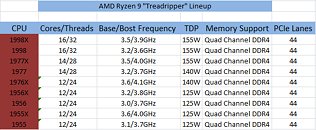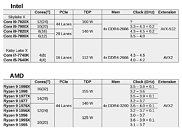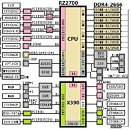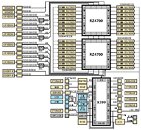Raevenlord
News Editor
- Joined
- Aug 12, 2016
- Messages
- 3,755 (1.19/day)
- Location
- Portugal
| System Name | The Ryzening |
|---|---|
| Processor | AMD Ryzen 9 5900X |
| Motherboard | MSI X570 MAG TOMAHAWK |
| Cooling | Lian Li Galahad 360mm AIO |
| Memory | 32 GB G.Skill Trident Z F4-3733 (4x 8 GB) |
| Video Card(s) | Gigabyte RTX 3070 Ti |
| Storage | Boot: Transcend MTE220S 2TB, Kintson A2000 1TB, Seagate Firewolf Pro 14 TB |
| Display(s) | Acer Nitro VG270UP (1440p 144 Hz IPS) |
| Case | Lian Li O11DX Dynamic White |
| Audio Device(s) | iFi Audio Zen DAC |
| Power Supply | Seasonic Focus+ 750 W |
| Mouse | Cooler Master Masterkeys Lite L |
| Keyboard | Cooler Master Masterkeys Lite L |
| Software | Windows 10 x64 |
Today is an eventful day in the tech world, with two high-impact leaks already offering themselves up to our scrutiny. We had previously covered AMD's upcoming HEDT platform, based on the company's new X399 chipset, as having a quite distinctive lineup of processors, with not only 16 and 12-core offerings hot on foundries presses', but also some 14-core, 28-thread chips as well. Now, a leak has apparently revealed the entire Ryzen HEDT platform, whose processor marketing name, Ryzen 9, sounds really close to Intel's Core i9.
AMD's offerings look to offer an edge at least on core-count, with the Red team's top offerings, the Ryzen 9 1998X and Ryzen 9 1998, bringing in a game-changer 16 cores and 32 threads to the table. Perhaps even more importantly, we have to mention that the 1998X (these names, if true, are quite a mouthful, though) achieves a 3.5 GHz base, 3.9 GHz boost clock, which owes nothing to AMD's Ryzen 7 1800X consumer flagship CPUs. Rumors of AMD's frequency demise on higher core-count Ryzen CPUs have been greatly exaggerated, it would seem. And did I mention that these chips are coming with a TDP of 155 W - 5 W lower than Intel's purported 12-core, i9-7920X offering? Consider that for a moment.



The 14-core parts are reported to be the Ryzen 9 1977X and Ryzen 9 1977. The Ryzen 9 1977X is a 155 W 14-core, 28-thread processor with a base clock speed of 3.5 GHz and a boost clock speed of 4.1 GHz with XFR. The Ryzen 9 1977 brings those speeds down a bit towards 3.2 GHz base and 3.7 GHz boost, with a correspondingly lower TDP of 140 W.
On to the 12-core parts, three different processors are expected: the Ryzen 9 1976X, Ryzen 9 1956X and the Ryzen 9 1956 (strange naming scheme with that 2-algharism difference between two parts with the same number of cores, I'd say.) The Ryzen 9 1976X is a 12-core, 24-thread, 140 W part, with a base clock 3.6 GHz and a boost clock speed of 4.1 GHz with XFR; the Ryzen 9 1956X lowers the TDP to just 125 W, on account of a lower base clock speed of 3.2 GHz and a boost clock speed of 3.8 GHz with XFR. The entry level 12 core part, the 1956, is rated at the same 125 W while running at a base clock speed of 3.0 GHz and a boost clock speed of 3.7 GHz.
There are also supposed to be two 10-core CPUs in this lineup, both rated at 125 W. The Ryzen 9 1955X, which runs at 3.6 GHZ base, and 4.0 GHz boost with XFR, and the Ryzen 9 1955, which runs at a base clock of 3.1 GHz and a 3.7 GHz boost.
I have to say, AMD is doing an amazing job with its Ryzen lineup, and the absolutely bonkers core-count on this X399, Whitehaven platform is most likely than not run circles around its Intel counterparts. Gone are the days of AMD's higher core count at the expense of computational power and IPC; as we've seen, AMD's Ryzen has achieved a great enough boost to its IPC that it can leverage its higher number, svelter cores over Intel's architecture, with absolutely mind-blowing TDP numbers (really, take another look at those TDPs in comparison to Intel's Core i9 series.)


AMD's Whitehaven platform looks to be an attractive prospect. Let's just hope AMD's platform stability and compatibility quirks are fully ironed-out until the expected June release.
View at TechPowerUp Main Site
AMD's offerings look to offer an edge at least on core-count, with the Red team's top offerings, the Ryzen 9 1998X and Ryzen 9 1998, bringing in a game-changer 16 cores and 32 threads to the table. Perhaps even more importantly, we have to mention that the 1998X (these names, if true, are quite a mouthful, though) achieves a 3.5 GHz base, 3.9 GHz boost clock, which owes nothing to AMD's Ryzen 7 1800X consumer flagship CPUs. Rumors of AMD's frequency demise on higher core-count Ryzen CPUs have been greatly exaggerated, it would seem. And did I mention that these chips are coming with a TDP of 155 W - 5 W lower than Intel's purported 12-core, i9-7920X offering? Consider that for a moment.



The 14-core parts are reported to be the Ryzen 9 1977X and Ryzen 9 1977. The Ryzen 9 1977X is a 155 W 14-core, 28-thread processor with a base clock speed of 3.5 GHz and a boost clock speed of 4.1 GHz with XFR. The Ryzen 9 1977 brings those speeds down a bit towards 3.2 GHz base and 3.7 GHz boost, with a correspondingly lower TDP of 140 W.
On to the 12-core parts, three different processors are expected: the Ryzen 9 1976X, Ryzen 9 1956X and the Ryzen 9 1956 (strange naming scheme with that 2-algharism difference between two parts with the same number of cores, I'd say.) The Ryzen 9 1976X is a 12-core, 24-thread, 140 W part, with a base clock 3.6 GHz and a boost clock speed of 4.1 GHz with XFR; the Ryzen 9 1956X lowers the TDP to just 125 W, on account of a lower base clock speed of 3.2 GHz and a boost clock speed of 3.8 GHz with XFR. The entry level 12 core part, the 1956, is rated at the same 125 W while running at a base clock speed of 3.0 GHz and a boost clock speed of 3.7 GHz.
There are also supposed to be two 10-core CPUs in this lineup, both rated at 125 W. The Ryzen 9 1955X, which runs at 3.6 GHZ base, and 4.0 GHz boost with XFR, and the Ryzen 9 1955, which runs at a base clock of 3.1 GHz and a 3.7 GHz boost.
I have to say, AMD is doing an amazing job with its Ryzen lineup, and the absolutely bonkers core-count on this X399, Whitehaven platform is most likely than not run circles around its Intel counterparts. Gone are the days of AMD's higher core count at the expense of computational power and IPC; as we've seen, AMD's Ryzen has achieved a great enough boost to its IPC that it can leverage its higher number, svelter cores over Intel's architecture, with absolutely mind-blowing TDP numbers (really, take another look at those TDPs in comparison to Intel's Core i9 series.)


AMD's Whitehaven platform looks to be an attractive prospect. Let's just hope AMD's platform stability and compatibility quirks are fully ironed-out until the expected June release.
View at TechPowerUp Main Site







